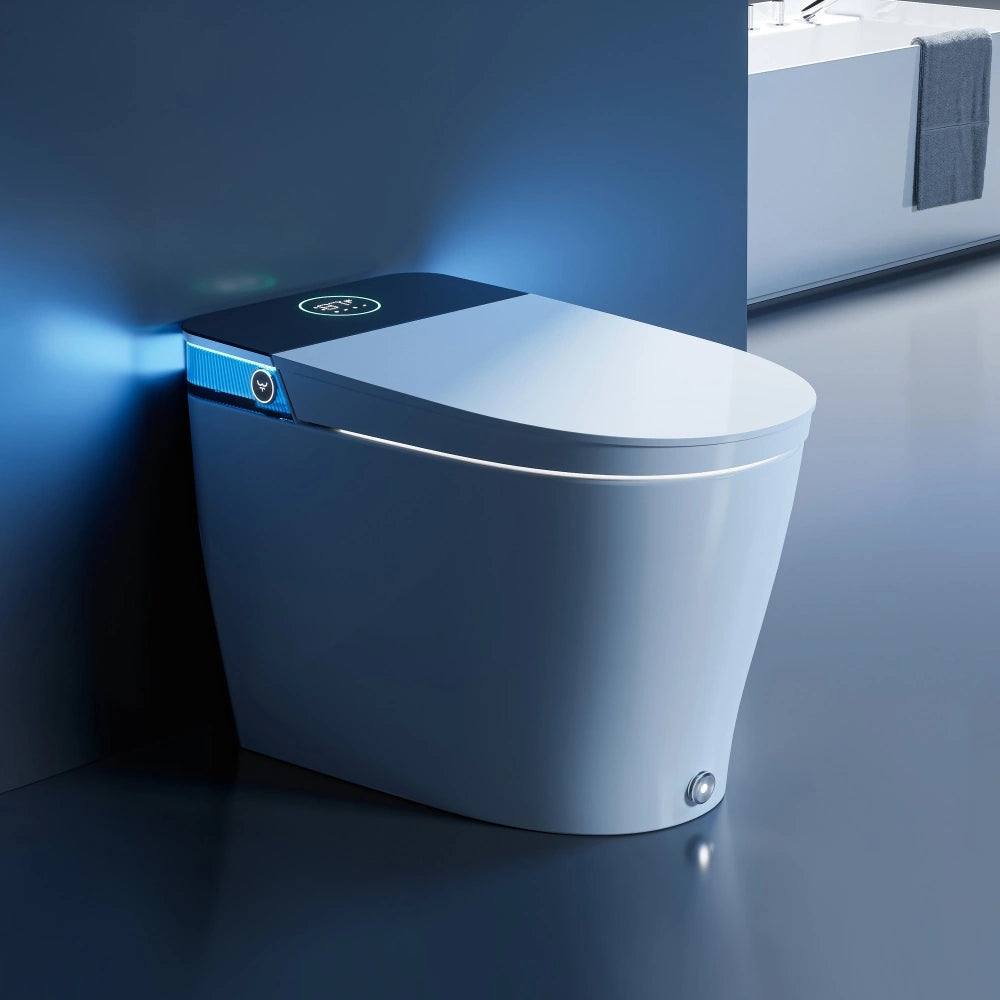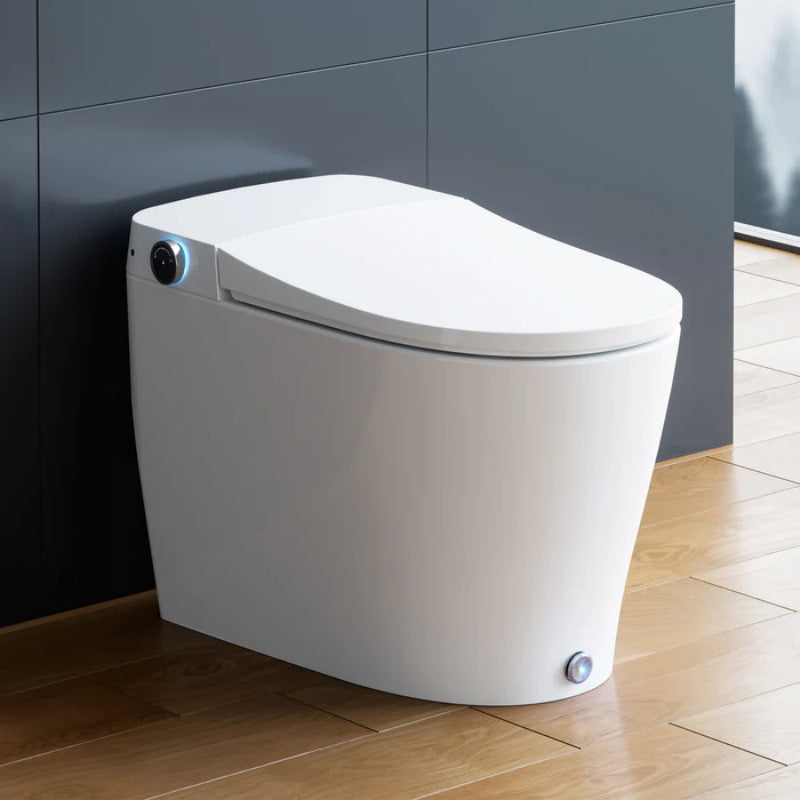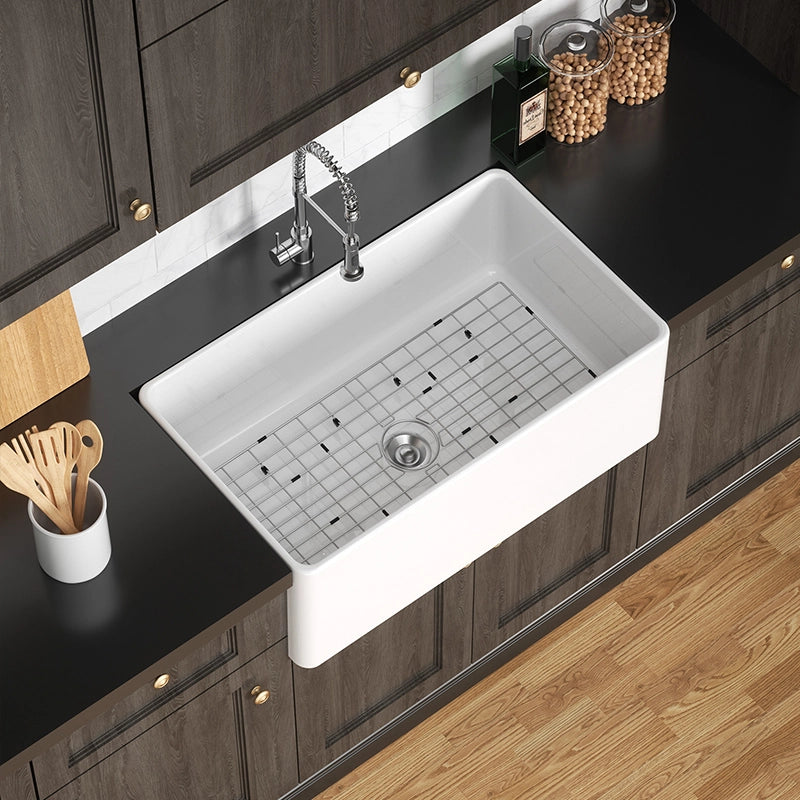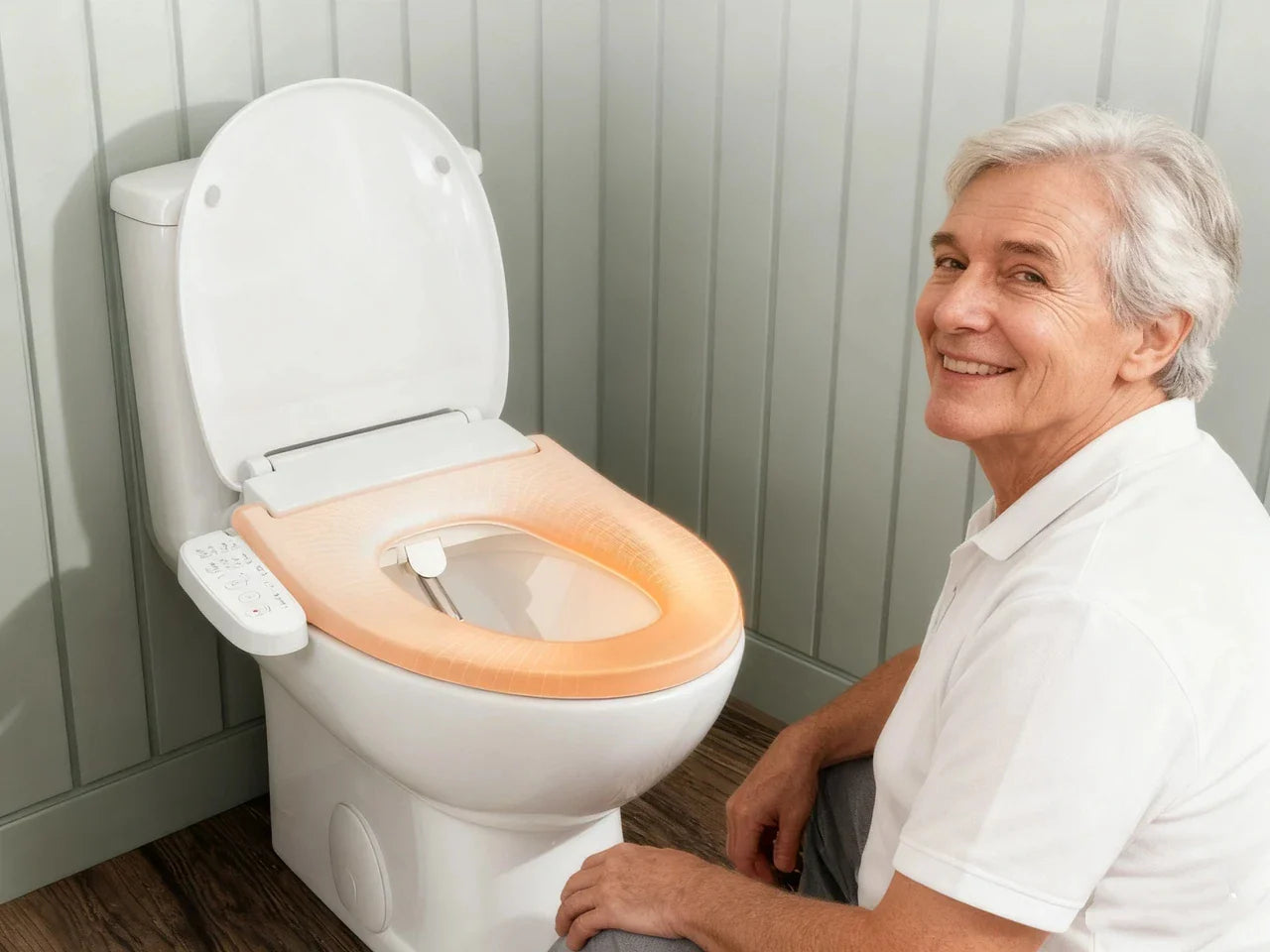A heated bidet can transform hygiene and comfort while cutting paper waste. In 2025, demand is surging for smart, tankless, electric seats with warm water washing, adjustable temperature, and app controls—all at accessible prices. This guide shows top picks, what to buy, and how to install, maintain, and save.
The Fast Path To Your Best Choice
Before diving into the details, let’s look at why heated bidets are becoming such a must-have. Comfort, hygiene, and technology are merging fast — and today’s electric bidet seats offer more than just warmth. They bring smart features, efficiency, and a touch of everyday luxury to your bathroom.
Why now
Electric heated bidet seats are growing quickly, with global growth estimated near 15% per year through the early 2030s. Smart, connected models are also rising. North America is projected to pass the halfbilliondollar mark by the end of the decade, while AsiaPacific leads production and adoption.
What to buy first
For most homes, pick a tankless, electric heated bidet seat. Look for adjustable water and seat temperature, pressure controls, a selfcleaning stainless nozzle, warm air dryer, and at least two user presets.
Who benefits most
Families, seniors, coldclimate homes, hygienefocused users, and smarthome adopters who want a bidet with warm water and simple controls.
Budget snapshot
You can spend about $50–$1,000+. Tankless smart seats tend to cost more, but have lower standby energy use and better comfort. Turn on energysaving modes to trim monthly costs.
Best Heated Bidet Picks (At a Glance)
Here’s a quick snapshot of the top heated bidet seats worth your attention. Whether you’re after comfort, value, or eco-efficiency, these picks cover every need and bathroom size—so you can find your perfect match fast.
Editor’s Picks (plugin seats):
- Best overall: Tankless smart heated bidet seat with continuous warm water, strong warranty, and two or more user presets.
- Best value: Reservoirheated seat that includes warm wash, seat warming, and a basic dryer under $300.
- Best for seniors: Sidepanel controls with large buttons, gentle spray start, warm air dryer, softclose seat, and night light.
- Best ecoconscious: Tankless model with energysaver scheduling, low water use per wash, and an effective dryer that can reduce toilet paper to near zero.
- Best for small bathrooms: Compact seat with ondemand heating, simple install, and a lowprofile tankless body.
What matters most:
- Heating type and temperature stability under real use
- Nozzle hygiene and materials
- Dryer performance and time to dry
- Fitment with your toilet bowl and clearance
- Warranty length, parts access, and serviceability
How Heated Bidets Work (Tank Vs. Tankless, Real Differences)
You’ll see two main heating systems. Both connect to your home’s clean tap water and use builtin heating to provide a bidet with warm water. The key differences relate to comfort, size, and efficiency.
Heating technologies
Reservoir (tank) heaters
These units keep a small internal tank warm. The warm water is ready right away, but it can run cool after a short wash because the tank empties. They usually cost less and are common in entrylevel electric seats.
Tankless/ondemand heaters
A tankless or ondemand heating bidet warms water as you use it. That means nearinstant and continuous warm water, with a slimmer body and no bulky tank. Tankless systems are popular for steady comfort, even with backtoback users.
Temperature control and stability
Quality seats let you set water temperature in steps (for example, room temp to pleasantly warm). A thermostatic controller keeps the temperature steady so you don’t get a surprise cold burst midwash. If several people use the bathroom in quick succession, tankless systems keep that warm feeling going, which is one reason smart reviewers and many users favor them.
Seat heating and comfort
The heated seat is often the first feature you notice. You can set it from mild to cozy, which matters in cold mornings. Safety sensors stop heating when no one is seated, and many seats add a soft night light for easier, safer use at night.
Smart controls and UX
Control options include:
- A slim remote you can mount on the wall
- A side panel with large, easytopress buttons
- App controls with presets and timers
Look for two or more user presets so each person can save spray position, pressure, and warm settings. Some seats offer autoopen/close lids and a gentle premist to keep the bowl cleaner.
Hygiene systems
Selfcleaning nozzles rinse before and after each use, and a separate sanitary guard protects the nozzle when it retracts. Stainless steel nozzles resist buildup and are easy to wipe clean. You’ll also see spray modes like oscillation (moves back and forth) or pulse (alternates pressure) for more complete cleaning. A builtin carbon deodorizer can help in small bathrooms.
Safety and standards
Heated bidets are electric appliances, so use a GFCI outlet near the toilet. Many seats include antibackflow valves to keep clean water from traveling back into your home line. Child locks prevent accidental sprays. Check for clear certifications and follow the manual for safe install and use.
Common questions, answered now:
- Should a bidet be heated? It’s optional, but a heated seat and warm water wash improve comfort, especially in colder homes or mornings.
- Do heated bidets need electricity? Electric seats do. Nonelectric attachments do not heat water or the seat.

Buyer’s Guide: Choose The Right Warm Water Bidet Seat
Choosing a hot water bidet or a heated seat comes down to fit, comfort needs, features, and budget. Here’s how to narrow it fast.
Fit and compatibility
Measure your toilet. Most seats come in round or elongated shapes. Make sure there’s enough clearance behind the seat for the body of the unit. Check where your water shutoff valve sits and whether a GFCI outlet is within cord reach. Some toilet brands have unique curves; a printable template or a fitment checklist helps. If you rent, stick to a noninvasive install and keep the old seat.
Comfort and customization
Look for:
- Adjustable water temperature and pressure with clear steps
- Nozzle position controls with oscillation and pulse modes
- A warm air dryer with adjustable temperature and airflow
A better dryer can reduce or even replace toilet paper, which helps comfort and the planet. Want a bidet with warm water that always feels right? Save a user preset so each person gets their favorite settings with one tap.
Reliability and warranties
A realistic lifespan is 5–10 years for wellmade seats. Warranty coverage often ranges from 1 to 3 years, sometimes longer for parts or the ceramic heating element. Check that the company offers spare parts, filters, hoses, and nozzles. Read how service works: is there a US or regional support center? Are repairs practical, or is it replaceonly?
Energy and water use
Electric seats draw a small amount of power in standby to keep systems ready. Eco timers or smart schedules lower that draw when you sleep or when a bathroom isn’t used much. A typical wash uses about 0.1–0.2 gallons of water — according to the U.S. EPA WaterSense program, that’s far less than what’s wasted through inefficient toilet flushing, which can use over a gallon per cycle (EPA WaterSense, 2024). Tankless heaters avoid keeping a big tank hot, so they can be more efficient from day to day.
Budget tiers
- Under $150: Nonelectric seats or simple attachments. They can spray, but usually offer cold water only, no heated seat, and no dryer.
- $150–$400: Entry electric seats with reservoir heating. You get warm water, a heated seat, and often a basic dryer and selfcleaning nozzle.
- $400–$800: Midtier smart seats with steadier heat, better dryers, presets, and night lights.
- $800+: Premium tankless seats with continuous warm water, strong drying, refined remotes, and extra comfort features.
Accessibility and special needs
For seniors or anyone with limited mobility, big buttons and a side panel can be easier than a small remote. A gentle spray start, an effective dryer, and a softclose seat help every day. Night lights reduce trips and slips. For families, user presets, a child mode (lower pressure and temp), and easyclean surfaces are worth it.
Common questions, answered here:
- Do bidets use cold or warm water? Electric seats provide warm water washing at set temperatures; nonelectric units use cold water unless you plumb a hot line.
- Do I need a hot water line for a bidet? For electric heated seats, no. They heat water internally from the regular cold water line. Nonelectric “hot/cold” attachments may connect to a nearby sink’s hot line if available.
- Where does bidet water come from? From the same clean tap water that feeds your toilet and sink, not from the bowl.

RealWorld Proof: Performance, Sentiment, And Trends
Heated bidets aren’t just trending—they’re transforming everyday hygiene. From rising sales to glowing user feedback, real-world data shows how comfort, convenience, and smart design are reshaping bathrooms worldwide. Here’s what the numbers and voices say.
Market momentum
Heated bidets are no longer niche. Electric heated bidet seats are expected to surpass $2 billion globally by 2025. Tankstyle systems ship in high volumes, while tankless smart seats lead comfort and efficiency. Online search interest in “heated bidet,” “smart toilet,” and “warm water bidet” has peaked through 2025, with shopping spikes around holidays and cold months.
Consumer sentiment highlights
Users praise warm seats, steady warm water, and easy controls. Many like how portable and simple most seats are to install with basic tools. Some point out ease of cleaning: smooth bodies and stainless nozzles are easier to wipe. On the downside, very lowpriced units can have durability or compatibility issues. A tankless seat helps reduce cold bursts and comfort complaints.
Social and content signals
On video platforms and forums, you’ll see consistent praise for tankless heating because it offers continuous warmth. Many posts share firsttime install tips and call out the value of a GFCI outlet. A common pain point is low pressure on budget units or a flimsy dryer. That’s why it pays to weigh dryer power and realworld temperature stability.
Sector case studies
In hospitality and healthcare, facilities report higher guest and patient satisfaction after adding warm water bidet seats. Homeowners describe less irritation, more independence for elderly family members, and better comfort in winter. The heated seat feature is often the “why didn’t we do this sooner?” moment.
Installation And Maintenance (StepByStep And Troubleshooting)
A typical plugin heated bidet seat installs in under an hour. You don’t need to open a wall or run a hot water line.
Stepbystep install:
- Gather tools: adjustable wrench, flat screwdriver, Tvalve (usually included), supply hose, and a towel.
- Turn off water at the shutoff valve and flush to empty the tank.
- Remove the old seat and clean the mounting area.
- Attach the new mounting plate using the existing holes.
- Install the Tvalve at the toilet tank’s water inlet; reconnect the fill hose to the top of the T.
- Connect the bidet’s supply hose to the Tvalve.
- Slide the seat onto the plate until it clicks.
- Turn water on, check for leaks, and snug connections as needed.
- Plug the cord into a nearby GFCI outlet.
- Pair the remote (if included) and test wash, position, heat, and dryer.
Maintenance checklist:
- Monthly: Wipe the seat and body, run the nozzle selfclean function, and gently clean the nozzle tip if removable.
- Every 6–12 months: Replace or rinse the inlet filter (if present).
- In hardwater areas: Descale per the manual; this keeps heaters and nozzles clear.
- Yearly: Inspect hoses, washers, and quickconnects for wear.

Troubleshooting quick hits:
- No warm water? Check that eco mode isn’t set to “off when idle,” verify water temp setting, and clean the inlet filter.
- Low pressure? Make sure the shutoff valve is fully open, look for a kinked hose, and clean the nozzle tip.
- Drips or leaks? Reseat the hose gaskets, tighten the Tvalve by hand plus a small wrench turn, and confirm quickconnects are fully engaged.
Landlord/renter tips:
- Keep your original seat to restore the bathroom at moveout.
- Use the included brackets; do not drill the toilet.
- Ask your landlord about adding a GFCI outlet if needed; it’s a safety upgrade for any bathroom.
Common questions in this stage:
- Can I install a heated bidet without a plumber? Most people can. If you’re adding a new outlet, hire a licensed electrician for a safe GFCI install.
- What happens during a power outage? The toilet still works, but the electric wash, heated seat, and dryer won’t. Nonelectric attachments spray using water pressure but won’t heat.
Health, Environment, And LongTerm Value
Heated bidets aren’t just about comfort—they bring real health, sustainability, and cost benefits. From gentler hygiene to lower paper use and long-term savings, here’s how they make everyday life cleaner, greener, and smarter.
Hygiene and wellness
A warm water wash is gentle on sensitive skin and can help many people reduce irritation. According to the Cleveland Clinic, using a bidet may support hygiene for people with hemorrhoids, postpartum discomfort, or limited mobility by reducing wiping friction and improving cleanliness (Cleveland Clinic, 2024). The key point is control: you choose temperature, pressure, and angle to match your needs.
Sustainability gains
A bidet with warm water can significantly cut toilet paper use. Based on NRDC’s “Issue with Tissue” report (2024), U.S. households could reduce paper waste and deforestation pressure by shifting away from high-consumption toilet paper toward bidet-based hygiene (NRDC, 2024). Water use per wash is modest, and tankless heating further improves energy efficiency by avoiding standby heating.
Cost of ownership
Think in two parts: upfront cost and fiveyear operating cost. Electric seats use a small amount of electricity daily and a bit of water per wash. Paper savings often cover a big portion of the purchase price over time. If your household uses several rolls per week, the payback can be quicker. Using the dryer can reduce paper even more, but it adds a little power use. In most homes, eco scheduling keeps the monthly cost modest.
Smart Home Integration And Emerging Features
Heated bidets are getting smarter every year. From app control to voice commands and self-cleaning tech, they’re blending comfort with connected living. Here’s a look at the latest smart features shaping the future of bathroom care.
IoT and apps:
- Control temperature, pressure, and dryer from your phone
- Set user profiles and usage logs
- Schedule eco modes while you sleep or travel
Voice and automation:
- Start a preset with a voice command (where supported)
- Use occupancy sensors for a prewarm seat and night light
- Trigger a lid open/close or even a smart flush with compatible toilets
Futureforward tech:
- UV sterilization for nozzles between cycles
- Better deodorization media and airflow tuning
- Predictive maintenance alerts for filter changes or descaling time

Advanced Comparison Criteria (For Expert Shoppers)
- Temperature stability during backtoback washes
- Dryer effectiveness vs. timetodry at different settings
- Nozzle hygiene design: retract angles, selfflush paths, tip material
- Build quality: hinges, seat material, water splash resistance
- Serviceability: how easy it is to replace filters, nozzles, hoses, and boards
- Noise levels: pump hum, dryer sound, and nightlight brightness
Tools And Interactive Aids (To Outperform Competitors)
Want to make your choice smarter and faster? These interactive tools help you find the perfect heated bidet seat for your needs—based on your toilet type, budget, climate, and daily habits. From quick quizzes to ROI calculators and fitment checkers, here’s how to outsmart guesswork and pick with confidence.
Model selector quiz
Answer these in order, then match your picks:
- Bowl shape? (Round or elongated)
- Budget? (<$200, $200–$400, $400–$800, $800+)
- Climate? (Cold, moderate, warm)
- Users? (Single, couple, family with kids, senior user)
- Top priorities? (Continuous warm water, strongest dryer, simple side controls, app presets, compact body)
Quick outputs:
- If you picked elongated, $400–$800, cold climate, family, and continuous warm water: choose a tankless smart seat with two user presets and a highoutput dryer.
- If you picked round, $200–$400, moderate climate, couple, simple controls: choose a reservoirheated seat with side panel and basic dryer.
- If you picked under $200 or renter needs: choose a nonelectric attachment for a fast install and low cost, knowing the water will be room temp unless you add a hot line.
5-year cost/ROI calculator
Inputs:
- Local power price (cents per kWh)
- Daily uses (per person × people)
- Eco schedule (hours per day in lowpower mode)
- Toilet paper spend (rolls per week × cost per roll)
- Dryer usage (always/sometimes/never)
Method:
- Estimate electricity: standby watts × hours + heating and drying time per use × uses × watts ÷ 1,000 = kWh per day. Multiply by local price and 30 days.
- Estimate water: 0.1–0.2 gallons per wash × uses × price per gallon (usually very low).
- Compare to paper savings per month. The difference shows payback time.
Example (simple):
If you save $12/month on paper and spend $3/month on power and water, your net is $9/month. A $450 seat would “break even” in about 50 months, faster if more people use it or if paper costs rise.
Fitment checker
- Printable template: confirm your bolttotank distance and side clearance
- Clearance checklist: at least 1.5–2 inches behind the bolts for most tankless bodies
- Plumbing/electrical readiness: shutoff valve within hose reach and a GFCI outlet within cord length
Conclusion — Key Takeaways And Next Steps
Heated bidet seats bring yearround comfort, better hygiene, and real savings. In 2025, tankless smart models lead for continuous warm water, steady temperature, and energysavvy controls. The right pick matches your bowl shape, comfort needs, and budget.
What to do now:
- Confirm fitment and outlet location
- Pick your priorities: continuous warm water, dryer strength, easy controls
- Compare two or three finalists across heating type, warranty, and serviceability
- Plan a simple onehour install, and set eco schedules on day one
Final tip: Prioritize tankless heating for comfort, a solid warranty for peace of mind, and energysaving modes for lower running costs. Your bathroom will feel warmer, cleaner, and a lot more modern.
FAQs
1. Should a bidet be heated?
A heated bidet isn’t absolutely necessary — but once you try one, it’s hard to go back! A warm seat and gentle stream of warm water make the whole experience far more comfortable, especially during colder months. Heated bidets are designed for comfort and convenience, and many models let you adjust the temperature to your liking. It’s a little luxury that can make your daily routine feel more spa-like, not just functional.
2. Do heated bidets need electricity?
Yes, most heated bidets need electricity to warm up the water and seat. They usually plug into a standard outlet near your toilet. Electric bidet seats have built-in heaters for both the seat and the water, and sometimes even include extra features like air drying and night lights. If you don’t have an outlet nearby, you can go for a non-electric model — it’ll still clean effectively, just without the warmth or extra features.
3. What is the downside of a bidet?
The main downside of a bidet is the initial setup and cost. Electric models can be pricier and might need a power source or minor plumbing adjustments. Some people also find that it takes a little time to get used to the sensation of water instead of toilet paper. Plus, if you don’t dry off completely, you might feel a bit damp. But honestly, most users say those minor inconveniences disappear once they experience how clean and fresh a bidet makes them feel.
4. Do bidets use cold or warm water?
That depends on the type of bidet you have. Non-electric or basic models usually use room-temperature or cold tap water. Electric bidet seats, on the other hand, come with adjustable heaters that let you choose a warm, gentle water temperature for better comfort. So, if you live somewhere chilly or just prefer a cozy wash, a heated bidet is a game changer.
5. Do bidets use warm water?
Not necessarily. Most modern electric bidets heat the water internally, so they only need a connection to your toilet’s cold water line. No extra plumbing required! However, if you choose a non-electric bidet attachment that offers warm water, it might need a connection to your bathroom sink’s hot water supply. Just check the model details before buying — the setup can vary.
6. Is the water from bidets clean?
Absolutely. Bidet water comes straight from your home’s clean water supply — the same source you use for washing your hands or brushing your teeth. It’s not recycled or “used” water, so there’s nothing to worry about. In fact, many people find bidets to be a more hygienic and gentle option compared to toilet paper since they rinse thoroughly with fresh, clean water every time.








Leave a comment
This site is protected by hCaptcha and the hCaptcha Privacy Policy and Terms of Service apply.